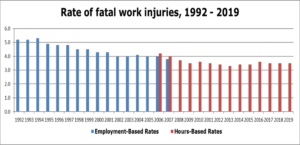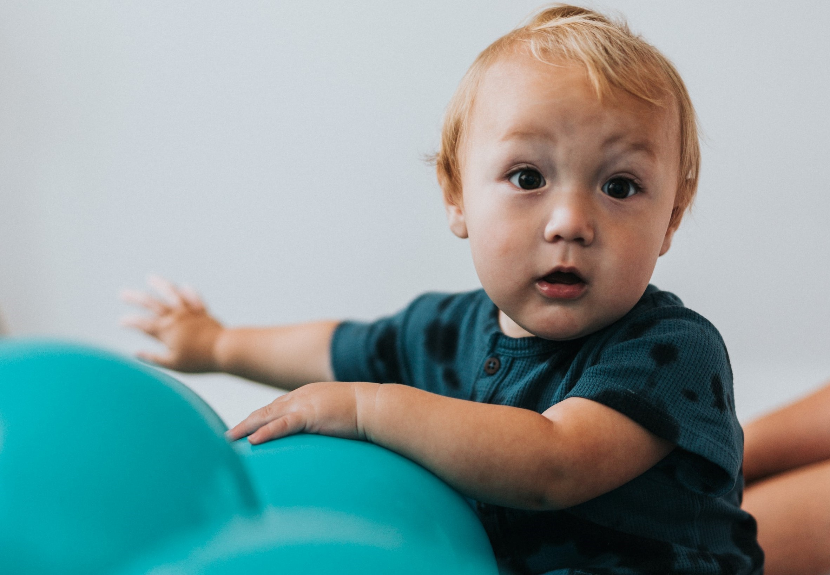“Squeezing a balloon in one place makes it expand in another.” — Bernd Debusmann
Finally. 2020, the worst year in living memory for most of us, is over. 2021 promises to be much, much better. Let’s make it a year when workplace safety gets better as well. To do that, though, we can’t just keep squeezing the balloon.
Workplace Safety Hasn’t Been Getting Better
There was a time when workplace got safer over the years. In 1970, when Richard Nixon signed into law the legislation that created OSHA, the work-related fatality rate was about 20 fatalities per 100,000 full time equivalents. With the promulgation of a wide variety of regulations—for general industry, for construction, for agriculture, for maritime industries—the fatality rate fell to 5.2 fatalities per 100,000 FTEs by 1992. It continued to fall until 2009, when it reached a level of 3.5 fatalities per 100,000 FTEs.

Work fatality rates, Bureau of Labor Statistics
Since then, we’ve flat-lined, stuck at around 3.5 fatalities per 100,000 FTEs. It’s almost as though this is a good as we are capable of. It’s not, though. Almost all our European neighbors do better. The UK, for instance, is four times safer.
We’re as Safe as We Want to Be
People are generally as safe as they want to be. People adapt their behavior to the risk they perceive. When they believe they are at greater risk, they behave with greater caution. Conversely, when they believe they are at less risk, they behave with less caution—more recklessly. I call this “The Law of Conservation of Recklessness” and it tells me that more safety rules aren’t going to make the workplace safer. When we compel people to be safer in one area, they will simply relax their diligence in another area. It’s like squeezing a balloon.
Instead, we need to take a two-pronged approach. First, we need to develop strategies to make the workplace safer without anyone knowing that’s what we’ve done. When the workplace is safer, while the perception of safety remains the same, people will remain as diligent as they were before.
Second, we need to find ways to help people want to be safer. When we are able to shift that point of equilibrium, people will naturally be more diligent about safety, even when all else remains the same. Their safety and the safety of their coworkers then gets the benefit of the most effective layer of protection in any workplace: a worker’s caution and care.
Balloon in a Bottle
There is a demonstration that science teachers sometimes share with their students called “balloon in a bottle”. Two holes are drilled in the cap of a bottle. One is sealed and the other is fitted with a balloon so that the balloon can be placed inside the bottle when the bottle is capped. When air is blown into the balloon, it does not inflate. The pressure inside the balloon increases, but so does the pressure of the air inside the bottle. When the seal on the second hole is removed, the balloon will suddenly expand, because it can now push the air in the bottle out.
The only way we can make workplaces safer is if we squeeze, not in one place, but everywhere. When all of society expects a safer workplace, it’s like the air pressure in the bottle. Safety gets better because everyone expects and demands that safety get better. Making excuses lets the air out of the bottle, and the safety balloon will expand to fill the bottle.
It’s still contained, but not as much as it could be. Until we figure out how to make the bottle smaller, though, we make the workplace safer by applying pressure to the balloon everywhere.
Sincere Communication is the Key
Short of a catastrophe, one of the most effective ways to change a culture’s expectations and demands for safety is sincere communication. Think of Upton Sinclair’s The Jungle and its impact on the meatpacking industry, of Rachel Carson’s Silent Spring and its impact on environmental regulation, of Ralph Nader’s Unsafe at Any Speed and its impact on automotive safety.
It doesn’t take the winner of a Nobel Prize for Literature to make a difference, though. Sincere communication can happen anywhere at any time. Dr. TJ Larkin, with Larkin Communication Consulting recently shared that “No other communication reduces accidents more than supervisors talking about safety.” He went on to add that about 2% of employees will change their behavior in response to a safety poster, while about 70% of employees will change their behavior when their supervisor asks them to.
Make 2021 the Year We Changed Safety
We’re in the catastrophe. The Covid-19 pandemic is not over yet, but it has forced us to demonstrate our ability to respond dramatically. Unfortunately, it has also demonstrated that without applying consistent, relentless pressure against it, it will come back. We are poised to emerge into a new normal. But to do that, we need to set new expectations. Not just anywhere at any time, but everywhere, all the time.
To be safer, we can’t just keep doing the things we’ve always done. What we’ve done has taken us as far as it is going to. We have to find a new way. We’ll do that by wanting to be safer and convincing the rest of our culture, whatever that culture is, to want to be safer, too.
